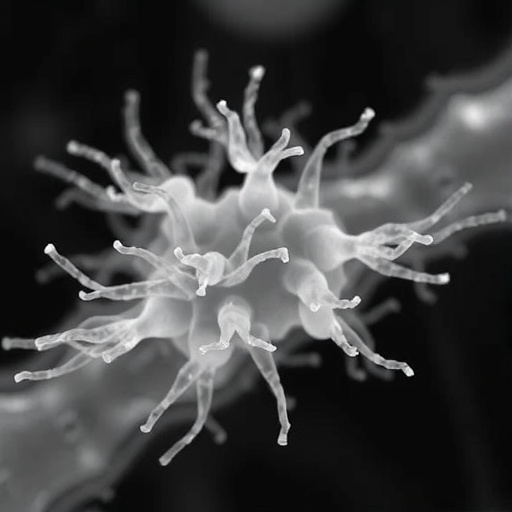
Researchers have made significant strides in understanding the virulence of Pasteurella multocida, a bacterium known for its role in various diseases in animals and, occasionally, humans. The study by Tawor, Erganiş, and Balevi focuses on the specific virulence genes associated with the cap B locus, which plays a crucial role in the pathogen’s ability to cause disease. The findings not only shed light on the genetic factors that contribute to disease severity but also raise the possibility of cross-protection mechanisms that could be harnessed for vaccine development.
Pasteurella multocida is notoriously recognized in veterinary medicine for causing respiratory infections, especially in poultry and livestock. However, its implications extend into zoonotic potential, making it a concern for public health. Understanding the genetics behind its virulence is paramount as it can lead to better management strategies in both animal health and human care. The cap B gene is integral to the capsule formation of the bacterium, which is a fundamental aspect that aids in evading the host’s immune system.
In their research, Tawor et al. describe various laboratory methods they employed to isolate and analyze the genes within the cap B locus. High-throughput sequencing was one of the critical techniques used, allowing for detailed observations of gene variations and their expressions. This molecular approach provided insights into how P. multocida adapts and thrives within host organisms, establishing a pathway to understand potential immune evasion tactics employed by this pathogen.
.adsslot_hk0XQ8ZzaJ{width:728px !important;height:90px !important;}
@media(max-width:1199px){ .adsslot_hk0XQ8ZzaJ{width:468px !important;height:60px !important;}
}
@media(max-width:767px){ .adsslot_hk0XQ8ZzaJ{width:320px !important;height:50px !important;}
}
ADVERTISEMENT
The potential for cross-protection is particularly intriguing. Through experimental models, the researchers administered different strains of P. multocida to mice and observed the immunological responses. The results indicated that prior exposure to specific strains equipped the immune system with a heightened defense mechanism against varied strains, suggesting that a universal vaccine might be feasible. This revelation opens new avenues for vaccine research and development, particularly against pathogens known for their antigenic variability.
Moreover, the researchers detailed the nuances of immunological responses observed in the tested mice. They noted the stimulation of both humoral and cellular immune responses which are critical in building lasting immunity. The presence of specific antibodies and T-cell activation demonstrated the potential effectiveness of using cap B in developing a comprehensive vaccine strategy. The differentiation between varying immune responses offers a framework for understanding how vaccines should be designed to elicit the strongest defense mechanisms.
The interplay between genetics and immunology presented in this study is a testament to the intricate networks that sustain pathogen survival and host resistance. The expression of virulence genes under different environmental conditions was also explored, showing how P. multocida might modulate its virulence in response to host immune pressures. This dynamic aspect is vital as it may contribute to the persistence of infections, making it harder to eradicate the bacterium from affected populations.
Beyond the implications for animal health, the study has significant public health considerations. As zoonotic diseases become more prevalent, understanding how P. multocida interacts with human immune systems can prevent potential outbreaks. The responsible transmission of this bacterium in human communities emphasizes the need for comprehensive epidemiological strategies, particularly focusing on high-risk populations such as farmers and veterinarians.
The ramifications of developing a vaccine leveraging findings related to the cap B gene could be transformative. If successful, it could not only assist in preventing diseases in livestock but also mitigate the spillover risks to humans. Vaccines that provide cross-protective effects offer a paradigm shift, shifting focus from species-specific responses to broader, more inclusive immunizations that can handle multiple strains of a pathogen.
As the research community delves deeper into the specifics of microbial genetics, such studies enable further technological advancements in vaccine manufacturing and delivery methods. The interdisciplinary approach integrating genomics, immunology, and epidemiology is vital to understanding and controlling infections caused by P. multocida and similar pathogens.
The potential for novel vaccine development introduces an exciting dimension to veterinary and clinical medicine. Utilizing the insights gained from understanding the genetics of virulence can lead to innovative immune therapies. This could include not only traditional vaccines but also therapeutic monoclonal antibodies, both of which could be tailored based on the genetic makeup of the pathogen.
In summary, the research on the virulence genes of Pasteurella multocida cap B not only enhances our understanding of the bacterium’s pathogenicity but also reveals its potential for cross-protection in vaccine development. This could prove crucial in combating infections in both livestock and humans, highlighting the importance of continued research in this area to safeguard public and animal health.
The merging of genetic insights with practical applications in vaccine development symbolizes a modern era of medicine that is heavily reliant on molecular biology and immunological principles. The ongoing evolution of pathogenic adaptability necessitates that scientific endeavors remain ahead of the curve, developing correspondingly robust solutions.
Finally, the insights provided by Tawor, Erganiş, and Balevi’s meticulously conducted research pave the way for future studies, ensuring that we remain vigilant against evolving pathogens and can provide safe, effective solutions to protect both animal and human health alike.
Subject of Research: Virulence genes of Pasteurella multocida cap B and cross-protection in mice.
Article Title: Virulence genes of Pasteurella multocida cap B and its potential cross protection in mice.
Article References:
Tawor, A.B., Erganiş, O. & Balevi, A. Virulence genes of Pasteurella multocida cap B and its potential cross protection in mice.
Int Microbiol (2025). https://doi.org/10.1007/s10123-025-00658-3
Image Credits: AI Generated
DOI: https://doi.org/10.1007/s10123-025-00658-3
Keywords: Pasteurella multocida, virulence genes, cross-protection, cap B, vaccine development, immunology, zoonotic diseases, pathogenicity, genetic adaptations.
Tags: cap B gene significancecross-protection mechanisms in bacteriagenetic analysis of pathogenshigh-throughput sequencing in microbiologyimmune evasion in bacteriaPasteurella multocida research advancementsPasteurella multocida virulence factorspublic health concerns with zoonosesrespiratory infections in livestockvaccine development strategiesveterinary medicine challengeszoonotic diseases in animals





